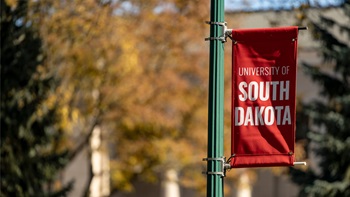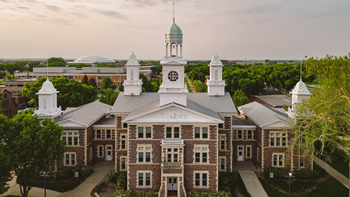Tana Zwart, Committed Advocate

Zwart is no stranger to community activism and volunteerism. As a youngster she first learned to give her time to good causes. Now, in her 30s, she serves as chair of the Disability Awareness and Accessibility Review Board (DAARB) for the City of Sioux Falls, South Dakota. She is also involved in other organizations as a volunteer, including the Muscular Dystrophy Association (MDA). Five years ago, she served as a national ambassador for that organization. She currently contributes to the Center for Disabilities’ Consumer Advisory Committee.
“There are many people who volunteer to help address the needs of people with disabilities,” Zwart explained. “I have evolved in my roles. Since moving to Sioux Falls nine years ago, I’ve been able to learn more about different disability issues. I’ve grown more comfortable working on issues related to people with disabilities.”
Zwart was diagnosed at age seven with facioscapulohumeral muscular dystrophy (FSHD), the third most common myopathy, affecting about 1 in 20,000 people. Individuals with FSHD show progressive weakness and atrophy of facial, shoulder and upper arm musculature.
“I have always been resilient,” said Zwart. “It was a long road to diagnosis that ended with a series of many tests at the Mayo Clinic. My parents never coddled me, and I had an amazing support system, including my parents, my grandparents, family members, even the community. When I reached middle school, I started feeling the effects of the disease. By the time I was a senior in high school I was using a scooter for mobility.” She now uses a wheelchair.
Zwart’s involvement as a volunteer supporting those with muscular dystrophy started when she was growing up in Edgerton, Minnesota. “My family and I were involved in fundraisers, and I appeared on local MDA Jerry Lewis telethon broadcasts,” she noted. “We felt like it was our way to do something about something we couldn’t really do anything about. It was turning a negative into a positive.”
Between her fifth and sixth grade years, Zwart attended MDA summer camp. “It was eye-opening,” she explained. “I was the only kid in my community with a disability, let alone muscular dystrophy, so going to that camp where there were so many others with disabilities helped me feel that it was okay just to be who I was.”
As chair of Sioux Falls’ DAARB, Zwart has opportunities to make a difference in her new community. One of the organization’s important initiatives is to encourage respect for parking spaces designated for individuals with disabilities. “People parking in these restricted spaces continues to be a problem,” reported Zwart. “We are placing a second and more personal sign below the disabled parking signs that request thoughtfulness and compliance with the signs.” The public awareness project, according to Zwart, features an image of a local model, accompanied by the messaging, Think of me—Keep it free.
Zwart also has a direct hand in helping organize ArtAbility, an annual show hosted by DAARB. This exhibit features artists with disabilities from the Sioux Falls area and across the state. The event is typically held each April, and last year more than 90 pieces of art were displayed. “Creativity doesn’t have limitations,” said Zwart. “The artists have a myriad of disabilities, and they do art in a variety of mediums.”
Another accessibility cause Zwart has embraced relates to air travel. “We need greater access on commercial flights for people in wheelchairs,” she explained. Zwart has lobbied in Washington, D.C. for supportive legislation and holds out hope for legislation now being considered.
Zwart was a perfect fit for her volunteer work with Rare by Design, a Sioux Falls-based nonprofit that expands public awareness and inclusion for individuals with rare diseases and disabilities. The organization, led by Center for Disabilities Communications specialist, Kendra Gottsleben, uses special and creative events like fashion shows and art exhibits to celebrate the unique and positive characteristics of each and every person.
“Tana is a community leader and a real asset to our organization,” stated Gottsleben. “She brings experience and enthusiasm to our mission.” Zwart, likewise, is grateful for opportunities to serve the organization. “Rare by Design is rewriting narratives commonly held about people with disabilities,” said Zwart. “I am especially excited about serving on the board of this organization.”
Zwart attended Southwest Minnesota State University in Marshall, where she studied graphic design, literature and creative writing. She now freelances as a self-employed media manager, focusing on nonprofits and the arts. “I like the variation of what I do and who I work with,” she explained.
Blending her skills and advocacy, Zwart has been able to make a difference for many on many fronts: board member, volunteer, lobbyist, community leader and activist. Her contributions range from fundraising to aid science and research, to raising the profile of people with disabilities.
“My involvement has been rewarding for many reasons,” said Zwart. “I have met many amazing people through my work. Most importantly, we are seeing changes for the better for those with disabilities.
This story was originally published in “South Dakota Possibilities 2023,” an annual publication by the University of South Dakota Center for Disabilities. Access the full issue at this link.
About the Center for Disabilities
The Center for Disabilities is part of a national network of federally designated centers known as University Centers for Excellence in Development Disabilities, Education, Research and Service (UCEDDS). The mission of the Center for Disabilities is to improve the lives of individuals with disabilities and their families across the state of South Dakota, the region and nationally. The Center for Disabilities carries out its diverse capacity-building efforts through clinical services, interdisciplinary training, continuing education, research, information dissemination and policy/advocacy work. Its work focuses on the strengths and contributions of people with disabilities, and works across multiple sectors including healthcare, education, mental health, and human services.



